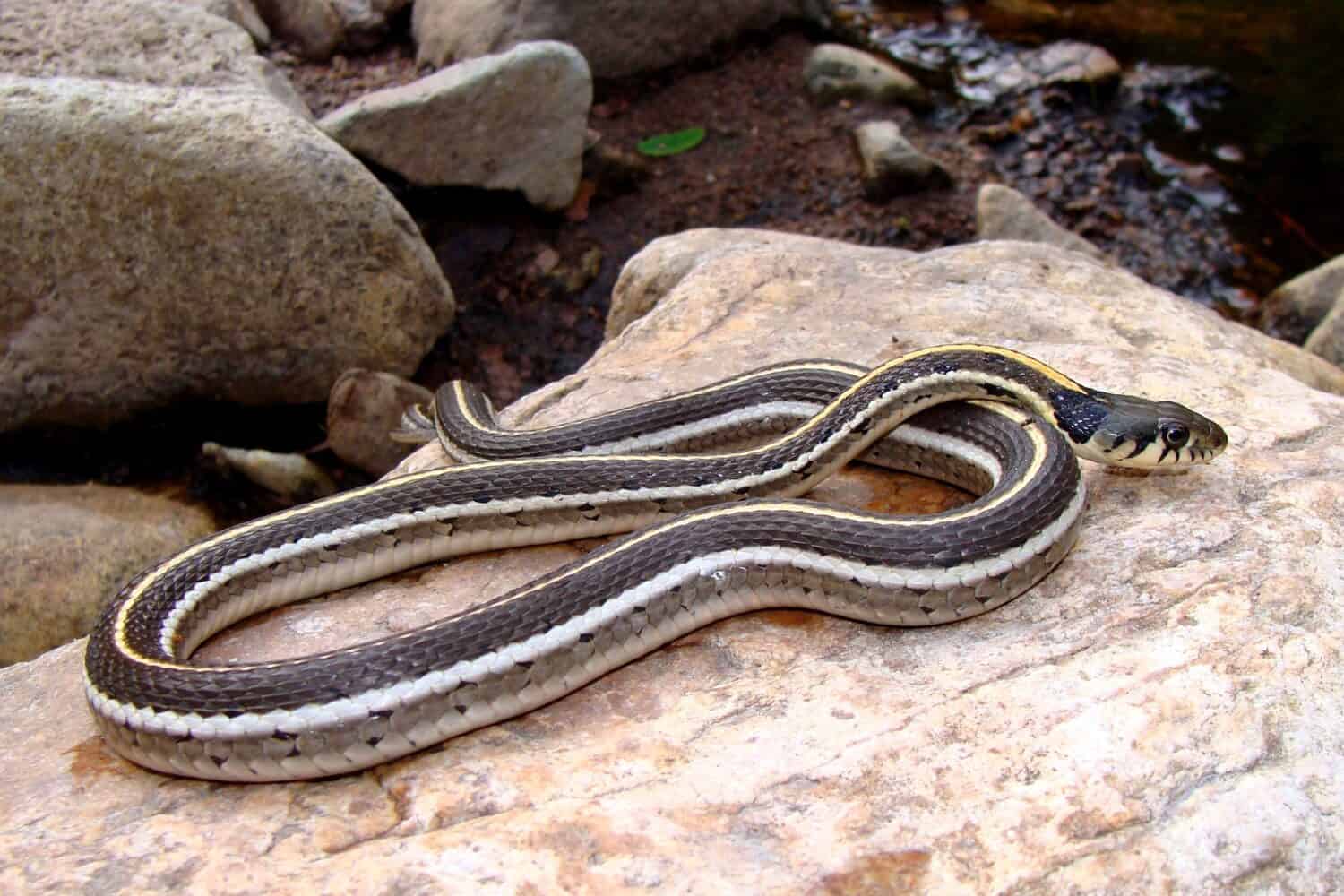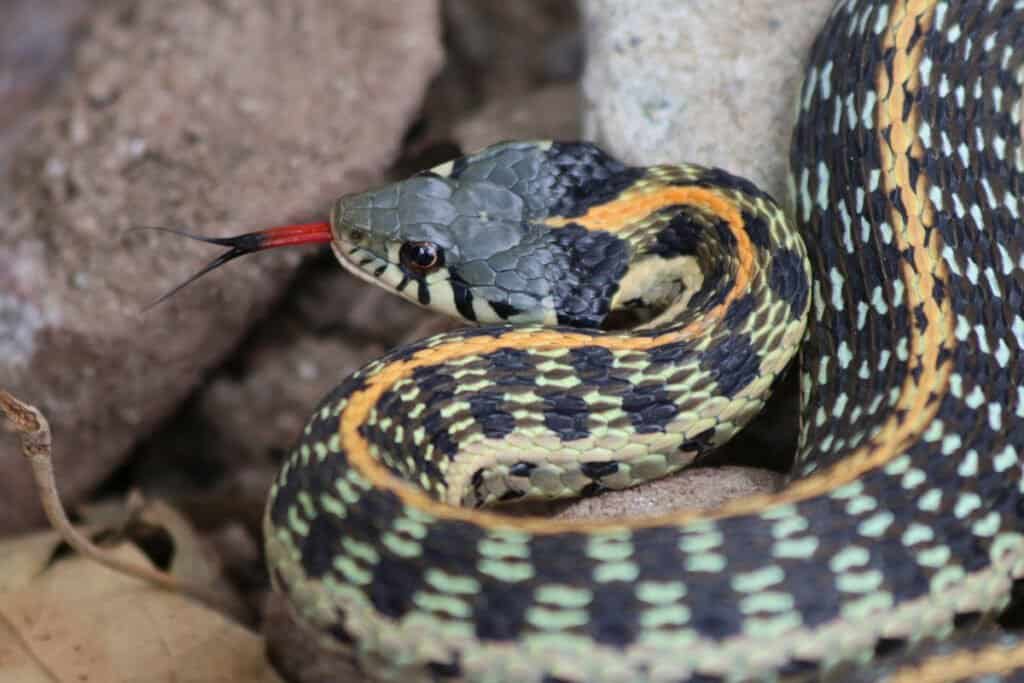What Is a Black-Necked Garter Snake
Black-necked garter snakes are one of the 30-plus species in the Thamnophis genus — which includes their cousins the ribbon and the common garter snakes. These harmless snakes are shy and often beat a hasty retreat when people and other bigger creatures get too close. Even if you are close to one, you may never see it!
Where to Find a Black-Necked Garter Snake
These snakes are spread across the southwestern U.S. from Texas to Arizona, and south into Guatemala.
Black-necked garter snakes are semiaquatic, spending a good portion of their time in the water. You won’t find them far from a water source, even though they are adaptable and thrive in many habitats.
Diet and Behavior: What Do Black-Necked Garter Snakes Eat?
Garter snakes are known for eating a variety of amphibians and their tadpoles — including frogs, toads, and salamanders. They also eat fish, lizards, and invertebrates available in their habitat.
Many reptiles are long-lived, these snakes may live 15 years. Black-necked garter snakes live in desert scrub, grasslands, canyons, foothills, forests, mountains, and woodlands – but always near water. They actively hunt during the day, using their excellent sense of smell and pretty good sight.
Black-necked garter snakes swallow their prey live in most cases. Some garter snake species have mild prey-specific venomous saliva and slightly enlarged rear teeth. So, yes – the spittle of some species is venomous. However, it is so mild that there are no records of people dying from it.
Like other reptiles, black-necked garter snakes sleep their way through colder months, from about October to March, depending on the temperatures.
How Can You Identify a Black-Necked Garter Snake?
All black-necked garter snakes have dark black bands right behind their heads, where their dorsal stripe begins. There are three subspecies, all with slight differences in their description and range.
Western black-necked garter snake (Thamnophis cyrtopsis cyrtopsis)
You will find this subspecies in the southwestern United States and Mexico — it’s the most widespread of the three subspecies. There’s a small, isolated population in Utah, but the rest are further south.
The nominate subspecies, western black-necked garter snakes might get to 42 inches in length. Their dark orange base color and orange-yellow dorsal stripe, matching black neck patches, and black bars around their labial (lip) scales make a beautiful snake.

Western black-necked garter snakes have an olive or brown base color with an orange-yellow dorsal stripe
©Matt Jeppson/Shutterstock.com
Eastern black-necked garter snake (Thamnophis cyrtopsis ocellatus)
Isolated in central Texas, the eastern subspecies has a striking body pattern — with dark circular markings along each side of their brightly colored dorsal stripe. Like all black-necked garter snakes, they have pitch-black patches on either side of their neck.
Tropical black-necked garter snake (Thamnophis cyrtopsis collaris)
This subspecies only lives in Mexico, from about the U.S.-Mexico border south to Oaxaca — most recorded sightings in iNaturalist are south of Durango.
These snakes usually stay less than two feet long. Their black neck patches pop against the lighter color of their dorsal stripe, which ranges from yellow to orange. The pattern on either side of their dorsal stripe often looks like a zigzag pattern against a lighter base color.
Identification Tips
Even some experts find garter snakes difficult to positively identify the species or subspecies. The differences between them are sometimes subtle and hard to spot. A few tips can help at least narrow down the possibilities.
Location. Where you are in the world helps determine which snake species you may encounter – many species only live in very small geographic locations. For example, a San Francisco red-sided garter snake only lives in a limited area in the San Francisco Bay area — it does not occur naturally in Utah.
Head shape, pupil shape, and neck thickness. Garter snakes have oval-shaped heads with round pupils and their necks are only slightly smaller than their heads. In contrast, rattlesnakes generally have big chunky heads with noticeably thin necks.
Body type and scales. Like their cousin garter snake species, these snakes have keeled scales and thin bodies. They do not have smooth, glossy scales like a kingsnake.

The eastern subspecies has a bright dorsal stripe and beautiful markings.
©Creeping Things/Shutterstock.com
Babies and Reproduction
While you may have believed that all reptiles lay eggs – that is only partially true. Many snake species essentially hold their eggs internally and allow babies to develop within the relative safety of their mother’s body. Then, when the babies are developed enough, the mother snake gives birth to her babies.
Black-necked garter snakes mate in the spring when they come out of brumation, then give birth in mid to late summer.
The photo featured at the top of this post is © Matt Jeppson/Shutterstock.com
Discover the "Monster" Snake 5X Bigger than an Anaconda
Every day A-Z Animals sends out some of the most incredible facts in the world from our free newsletter. Want to discover the 10 most beautiful snakes in the world, a "snake island" where you're never more than 3 feet from danger, or a "monster" snake 5X larger than an anaconda? Then sign up right now and you'll start receiving our daily newsletter absolutely free.
Thank you for reading! Have some feedback for us? Contact the AZ Animals editorial team.






